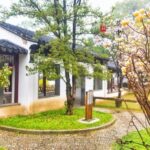Kezhi Garden is located in the northwest of Zhujiajiao Ancient Town. It is a large garden architecture in the local area. The garden has small bridges and flowing water, and every step is a scene. It is a paid scenic spot worth visiting in the ancient town, and the environment is quiet and secluded. Kezhi Garden was built in 1912 and took 15 years to complete. It was once the private residence of local tycoon Ma Wenqing. The design structure and decorative building materials used in this garden mostly adopt a combination of Chinese and Western styles, which is a characteristic of Kezhi Garden. Kezhi Garden’s gate is adjacent to the water alley. The entrance looks ordinary, but there is a hidden paradise inside. Especially after passing through several halls, a huge garden will be seen. Kezhi Garden is divided into two major parts: Keyuan and Zhiyuan. Keyuan is the living and learning area of the owner’s family. Zhiyuan is the entertainment and farming area. The two characters ‘Kezhi’ imply the meaning of ‘not forgetting farming while studying’, showing the peaceful mentality of the garden owner’s farming and reading to maintain his family. First, enter the continuous hall buildings, including the sedan hall, living room, and welcoming hall. The halls are richly decorated with carved beams and painted pillars. The roof surface adopts a double-layer tile slab structure, which has the miraculous effect of being warm in winter and cool in summer. At the back of the first hall, there are fine brick carvings at the entrance gate, everywhere showing the luxurious style of a wealthy family. Passing through the halls is a winding path leading to the garden. The Moon Viewing Tower and Book City are the most typical Chinese and Western combined buildings in the garden. In the stele corridor in the garden, there are inlaid handwritten stone carvings such as poems and letters of the four talented scholars of the Ming Dynasty, Tang, Zhu, Wen, and Zhou. There are ponds, rockeries, pavilions and towers in the garden. There are also stages, zigzag bridges, and the upside-down lion pavilion on the rockery. The plants in the garden are very lush. Walking in the green path, you can feel tranquility and peace. Different from many Jiangnan gardens, there are also rice fields, vegetable fields and fruit orchards deep in this garden, named ‘Daoxiang Village’. This was to let the children and grandchildren of the garden owner Ma Wenqing experience the hardships of farmers’ farming and the family management concept of ‘farming nine and leaving three’. And he himself often works in the fields as an example. Opening hours: Open all year round from 08:30 to 16:30.
Kezhi Garden
Kezhi Garden is located in the northwest of Zhujiajiao Ancient Town. It is a large garden architectu[...]









